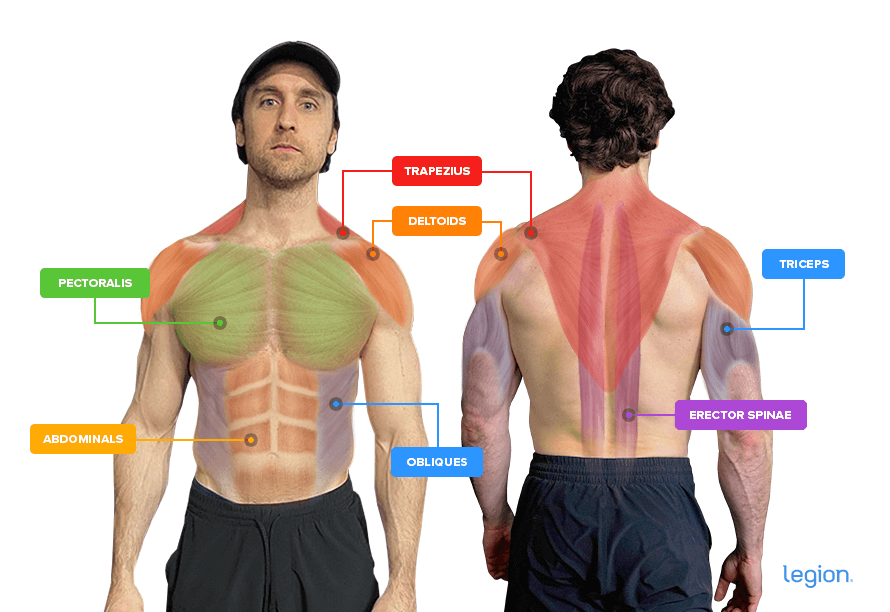When people first see the barbell Z press, they often wonder why anyone would choose a “sitting-on-the-floor shoulder press” over a more stable overhead press variation.
But it’s actually because you sit on the floor that the Z press is so effective.
By removing your lower body support, the seated Z press forces you to rely solely on your upper body muscles to balance and lift the weight, which can boost muscle and strength gain in your shoulders, triceps, upper back, and core, burnish your overhead pressing technique, and enhance athletic performance.
In this article, you’ll learn how to perform the Z press with proper form, get tips on how to include it in your program, discover the best barbell Z press exercise variations, and more.
How to Do the Barbell Z Press
To master the barbell Z press, split the exercise into three parts: set up, press, and descend.
1. Set up
Adjust the safety pins in a power rack or squat rack to 1-to-2 inches below shoulder height when you’re sitting on the floor.
Place a barbell on the pins and sit on the floor in the middle of the rack 1-to-2 inches behind the bar. Extend your legs in front of you and position your feet 2-to-3 feet apart.
Grip the barbell slightly wider than shoulder-width apart, with your palms facing away and thumbs wrapped around the bar.
Lean forward until the bar touches your upper chest, take a deep breath into your stomach, lift the bar off the pins, and sit upright with your torso perpendicular to the floor, resting the bar on your shoulders and upper chest.
2. Press
While driving the backs of your knees into the floor, press the bar straight upward.
Lean back slightly to allow the bar to pass your face, then push your head and chest forward under the bar as it passes your eyes.
Keep pushing the bar toward the ceiling until your arms are straight.
3. Descend
Reverse the movement and return to the starting position.
Here’s how it should look when you put it all together:
How to Program the Barbell Z Press
For most people, the barbell Z press is an “accessory exercise” (an exercise that enhances your performance on another exercise) for the barbell overhead press.
As such, it’s best to program it during a push, shoulder, or upper body workout once you’ve finished your main, heavy pressing for the day.
Because of its inherent instability, it’s also typically best to train in a slightly higher rep range than you would on the regular overhead press. Sets of 6-to-8 or 8-to-10 reps work well for most.
For example, here’s how you might add the barbell Z press to a shoulder workout:
Z Press: Muscle Worked
The main muscles worked by the Z press are:
Here’s how these muscles look on your body:

The Best Barbell Z Press Exercise Variations
1. Dumbbell Z Press
The dumbbell Z press trains your upper body similarly to the barbell variation. Its main benefit is that it doesn’t require a rack, so you can perform it with minimal equipment. Additionally, you don’t have to sway out of the way of the bar as you lift and lower the weight, which means it requires slightly less coordination.
That said, setting up the dumbbell Z press can be tricky without a rack, especially as the weights get heavier.
2. Kettlebell Z Press
Because kettlebells are unevenly weighted, your core has to work even harder during the kettlebell Z press to stabilize your upper body. However, like the dumbbell Z press, the setup can be tricky without a rack, particularly with heavier kettlebells.
3. Landmine Z Press
The barbell is on a fixed, diagonal path in the landmine Z press, making it more stable and comfortable for those with shoulder issues.
Benefits of the Z Press
Improved Upper Body Size and Strength
In most overhead pressing exercises, your legs stabilize your entire body, making it easier to balance and press heavy weights. People often also use their lower body—bending and straightening their knees or thrusting their hips—to produce momentum that helps them lift more weight.
In the Z press, you can’t use your lower body, so you have to rely entirely on your upper body to lift the weight, which can help you gain more upper body mass and strength.
Better Overhead Pressing Mechanics
You can get away with fumbling your form slightly during most overhead presses.
For example, you might lean too far backward as you press the weight off your chest, rock onto your toes as you lock out your arms overhead, or use your legs to generate momentum.
While these errors might not matter much with lighter weights, they can hinder performance and increase injury risk as the weights get heavier.
Conversely, the Z press leaves no room for error, forcing you to use precise, efficient technique, which improves your performance when you return to the regular overhead press.
Enhanced Athletic Performance
The Z press helps you develop core stability better than any other pressing exercise.
This is significant because research shows that having a strong, stable core is crucial for optimizing athletic performance: it enhances force transfer, movement control, balance, and explosiveness.
Common Z Press Mistakes
Lifting your legs.
If your legs lift during a rep of the Z press, you risk toppling backward, which increases your odds of getting injured.
It’s usually an indication that you lack the required hamstring and hip mobility, so the best way to fix it is to improve your lower body flexibility. Check out this article to learn how:
The Definitive Guide to Mobility Exercises: Improve Flexibility, Function, and Strength
Leaning back.
Leaning back during the Z press helps you lift more weight by allowing you to engage more muscles and use momentum to “cheat” the weight up. However, this defeats the exercise’s purpose—to train the shoulders—and increases the likelihood you’ll tweak your lower back.
The solution is usually to use lighter weights. While this may not stroke your ego as much, it ensures the exercise is safe and trains the target muscles.
Not bracing correctly.
Bracing your core is vital in the Z press for a few reasons:
- It helps you stabilize your upper body.
- It provides a solid foundation for transferring force into the weight.
- It protects your lower back from excessive arching or rounding.
Thus, to perform the Z press correctly and safely, you have to learn how to brace your core. Check out this article to learn how:
The Complete Guide to the Valsalva Maneuver
FAQ #1: What is the Z press for?
Weightlifters typically use the Z press as an accessory exercise to improve their overhead press performance. They do this because the Z press allows you to train all the primary muscles involved in overhead pressing and helps ingrain proper overhead pressing form, which is vital for pressing efficiently.
FAQ #2: Why is the Z press so hard?
The barbell Z press is more challenging than other overhead pressing exercises because you can’t use your lower body for stability. This forces your upper body, especially your core, to help you balance, which greatly limits how much weight you can lift.
FAQ #3: Is the Z press better than the shoulder press?
The Z press and the shoulder press each have unique benefits and serve different purposes.
The Z press is excellent for building strict shoulder strength, learning proper overhead pressing technique, and improving upper body stability, which can boost your performance on the regular overhead press.
On the other hand, the shoulder press allows you to lift heavier weights and train through a slightly longer range of motion, making it better for building upper body muscle.
In most cases, you don’t have to pick just one, though. Typically, the best solution is to include both in your program. A good way to do this is to alternate between the Z press and shoulder press every 8-to-10 weeks of training.

